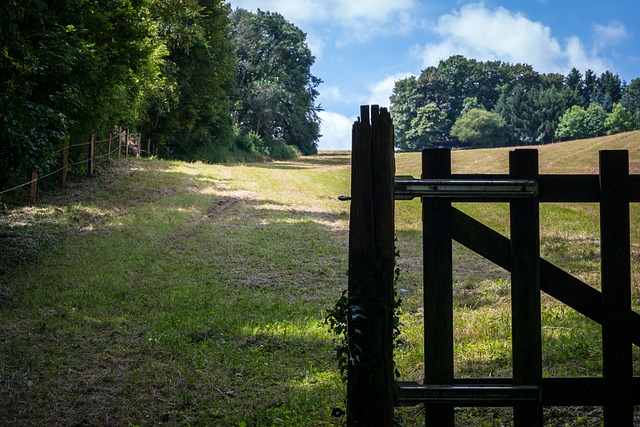Large properties present unique challenges when it comes to fencing, requiring solutions that balance aesthetic appeal with affordability. This article guides homeowners through an array of cost-effective fencing options tailored for expansive spaces. We explore budget-friendly materials, innovative design strategies, and installation techniques to maximize savings without compromising quality. Furthermore, we delve into maintenance practices designed to extend the lifespan of your fence while minimizing future expenses. By the end, you’ll be equipped with the knowledge needed to transform your property’s perimeter into a stunning, cost-efficient feature.
- Understanding Fencing Needs for Large Properties
- Budget-Friendly Materials: A Comprehensive Look
- Creative Design Ideas to Save Costs
- Installation Tips for Efficient Cost Savings
- Maintenance Strategies to Extend Lifespan and Cut Expenses
- Case Studies: Successful Cost-Effective Fencing Projects
Understanding Fencing Needs for Large Properties
Fencing large properties presents unique challenges compared to smaller plots due to increased perimeter length and diverse landscape features. Property owners must consider both aesthetic preferences and practical needs, such as security, privacy, and protection for livestock or plants. A thorough understanding of these requirements is essential before selecting fencing solutions.
For instance, homeowners with expansive meadows or gardens may seek natural-looking fences that blend with the surroundings, while those with valuable assets or vulnerable areas might prioritize high-security barriers. Additionally, terrain irregularities like hills, valleys, and trees necessitate tailored fence designs to ensure structural integrity and effective containment.
Budget-Friendly Materials: A Comprehensive Look
When considering fencing for large properties on a budget, exploring cost-effective materials is a strategic move. Options like vinyl and wood are popular choices due to their affordability and versatility. Vinyl fencing, in particular, offers durability and low maintenance, making it an attractive option for those seeking long-term savings. It’s available in various styles, from traditional picket fences to more modern designs, catering to different aesthetic preferences while keeping costs down.
Wooden options, such as cedar or pressure-treated timber, are another budget-friendly choice. While initial costs may be lower than other materials, wood requires regular maintenance like painting or staining to prevent rot and insect damage. Despite this extra upkeep, wooden fences can provide a natural, aesthetically pleasing look that enhances the property’s curb appeal without breaking the bank.
Creative Design Ideas to Save Costs
When it comes to fencing large properties, creative design ideas can significantly reduce costs without compromising on aesthetics or functionality. One cost-saving approach is to incorporate natural materials like wood or bamboo into your fence design. These materials are often more affordable than traditional metal or concrete fences and can add a warm, rustic charm to your property. Additionally, using local, sustainable resources not only saves money but also contributes to environmental conservation efforts.
Another innovative idea is to opt for custom-made or DIY fencing solutions. Custom designs allow you to incorporate unique features that cater to specific needs and preferences, all while keeping costs down. Do-it-yourself kits offer a more affordable option, enabling you to create a fence tailored to your budget and vision. These creative approaches not only reduce expenses but also add a personal touch to your property’s exterior.
Installation Tips for Efficient Cost Savings
When installing fencing on large properties, efficient cost savings can be achieved by prioritizing strategic planning and proper technique. One crucial tip is to measure and plan your fence layout accurately before purchasing materials. This minimizes waste and ensures you buy exactly what’s needed. Additionally, consider the terrain; for instance, pre-paged or roll fencing might be more economical and suitable for slightly sloped areas compared to custom-built posts and rails required for steep slopes.
Another installation tip is to group fence projects together. Multiple smaller jobs can be completed simultaneously, reducing labor costs. Enlist the help of friends or family during non-peak seasons for tasks like post setting, stringing wire, or installing panels, which can significantly lower overall expenses.
Maintenance Strategies to Extend Lifespan and Cut Expenses
Regular maintenance is key to extending the lifespan of any fencing system, especially for large properties where the investment can be significant. A simple yet effective strategy is to establish a consistent cleaning and inspection routine. This involves removing debris, such as leaves and branches, which can accumulate over time and potentially cause damage. Regular cleaning also prevents the buildup of moisture, which can lead to rust or rot in metal fences or weaken wooden posts.
Additionally, inspecting the fence for any signs of wear, decay, or breakage should be done on a scheduled basis. Addressing small issues early on can prevent them from escalating into costly repairs later. For example, repairing or replacing individual pickets or panels can be much more economical than complete fence replacement. Many fencing materials also benefit from occasional sealing or staining to protect against the elements, ensuring long-lasting performance and saving money in the long run.
Case Studies: Successful Cost-Effective Fencing Projects
In the realm of large property fencing, cost-effectiveness doesn’t mean sacrificing quality or durability. Several case studies illustrate this point beautifully. One successful project involved a sprawling rural estate that opted for a custom-built wooden fence. By utilizing locally sourced materials and employing efficient construction methods, the project team managed to install a robust fence while adhering to a tight budget. The result was a natural-looking barrier that not only defined property lines but also enhanced the aesthetic appeal of the landscape.
Another notable example is a suburban property that faced noise pollution from nearby highways. The solution? A sound-absorbing fence made from recycled materials. This innovative approach not only reduced noise levels significantly but also provided privacy and security. The cost-effectiveness lay in the use of repurposed materials, making it an environmentally friendly choice as well. These case studies demonstrate that prioritizing sustainability and quality can lead to successful fencing projects without breaking the bank.
